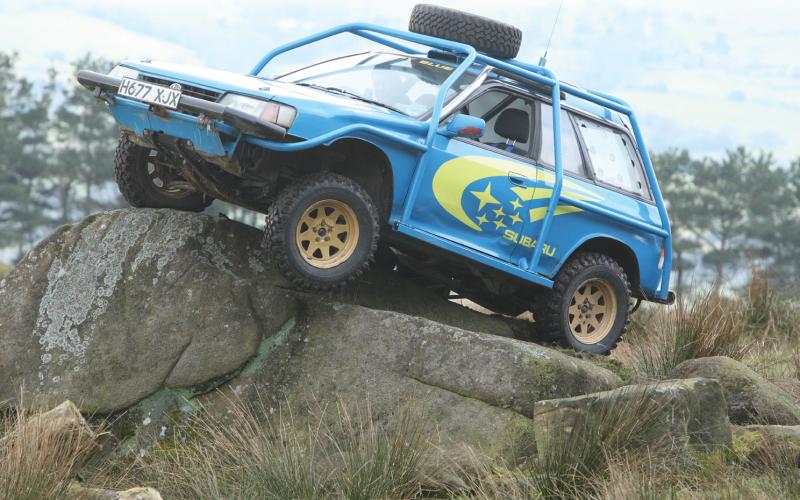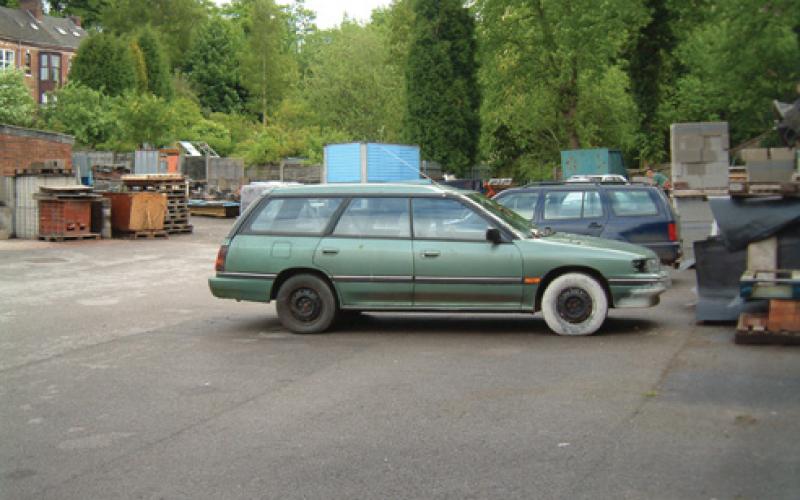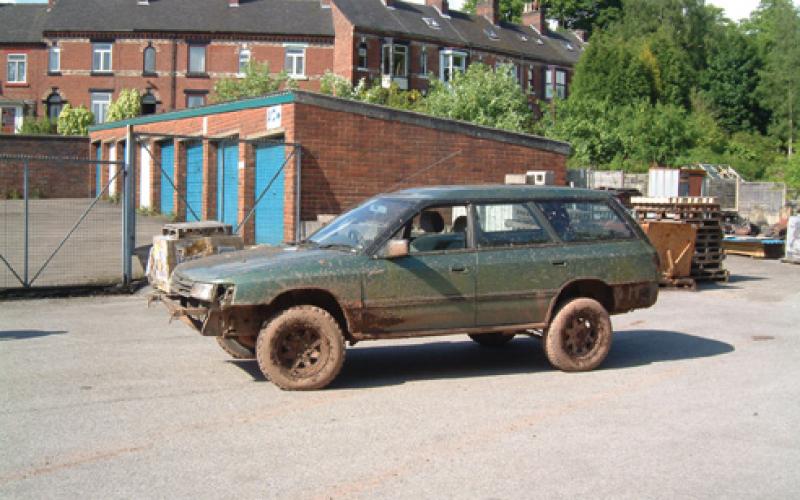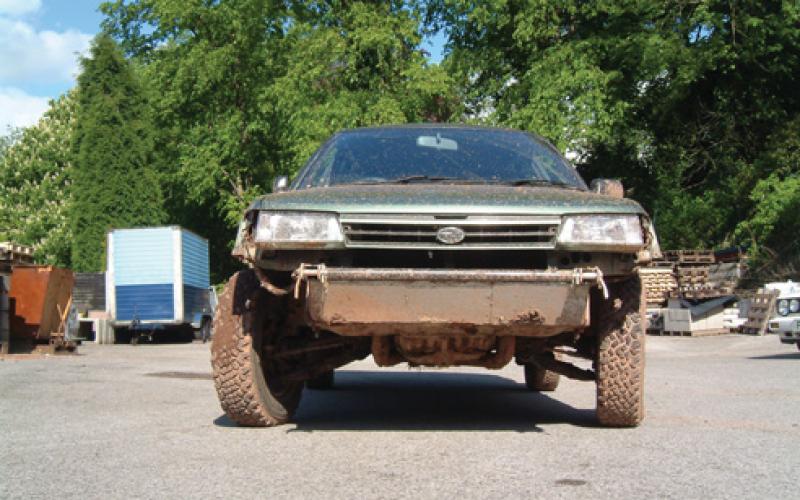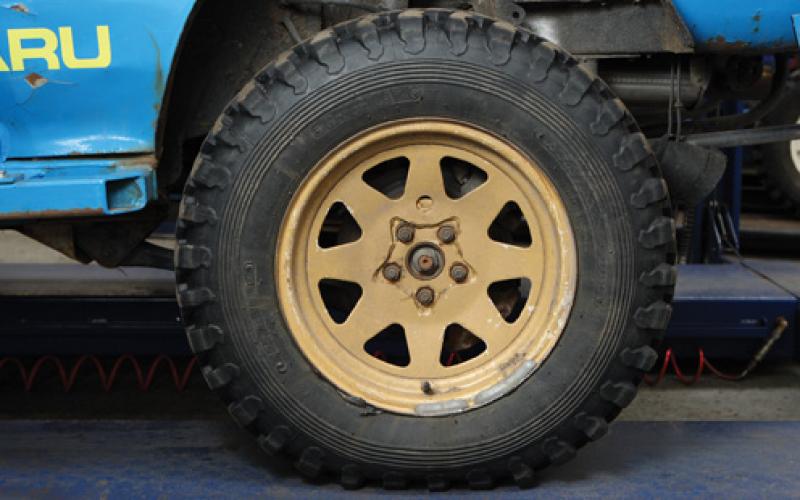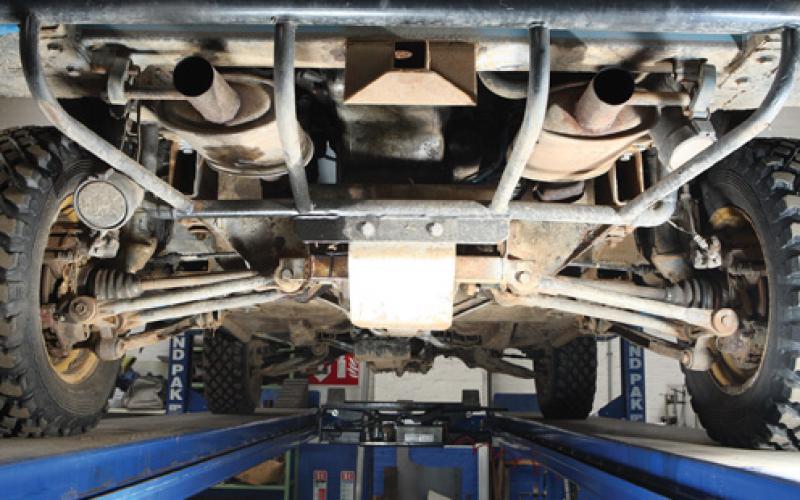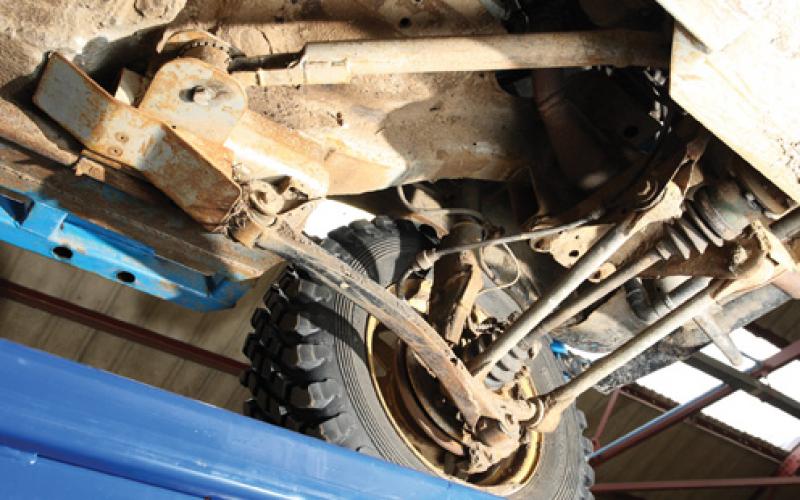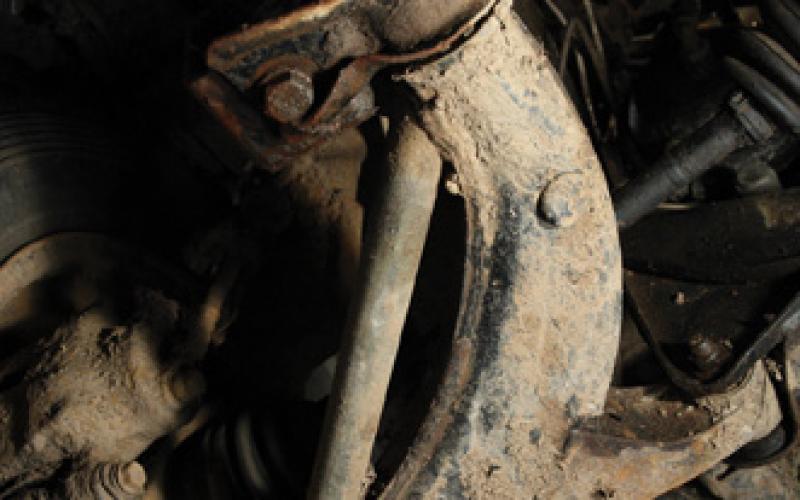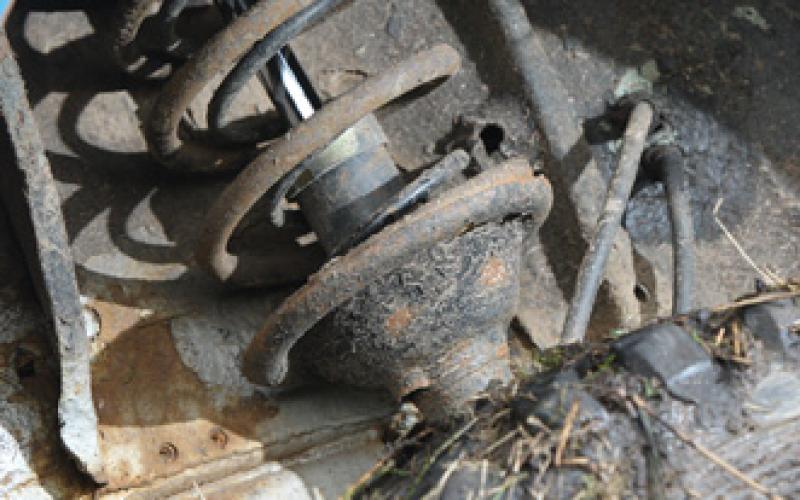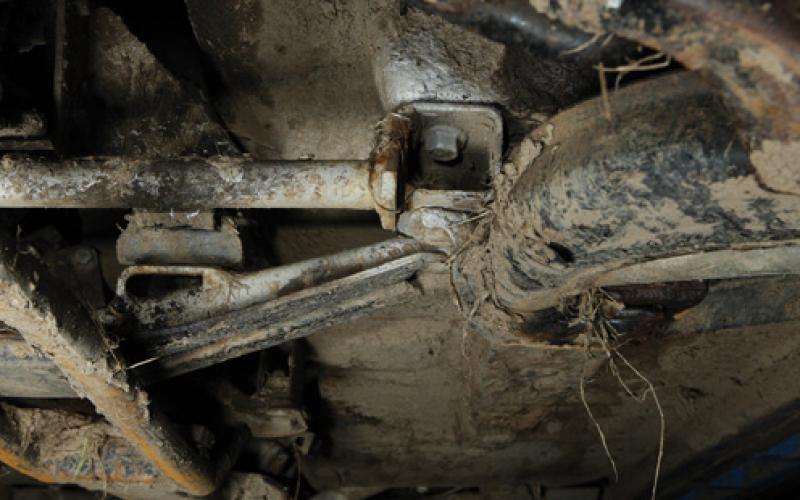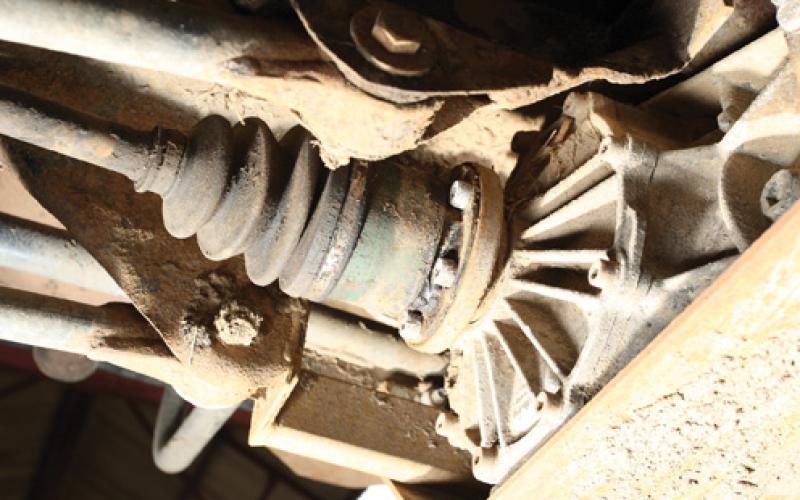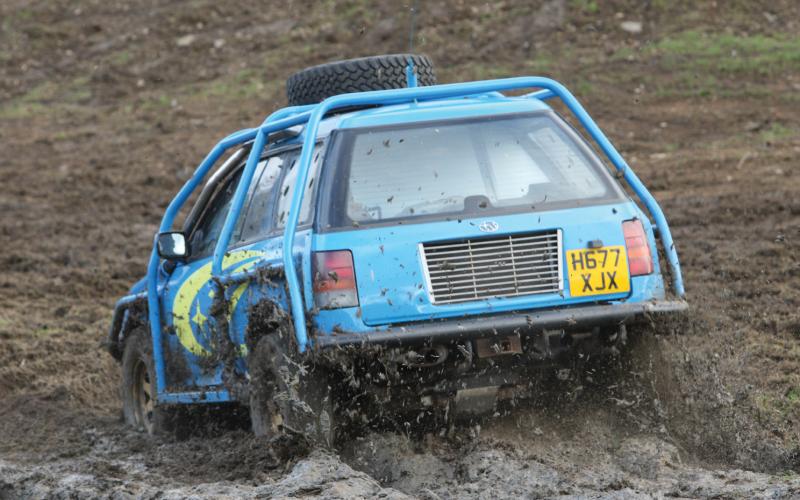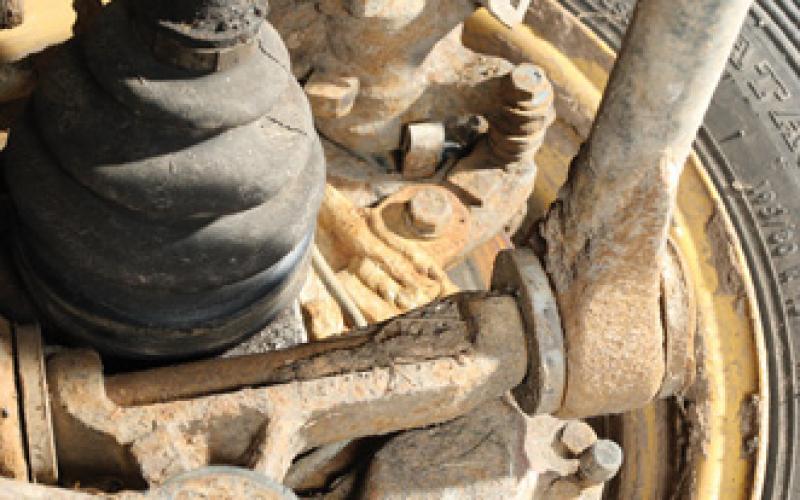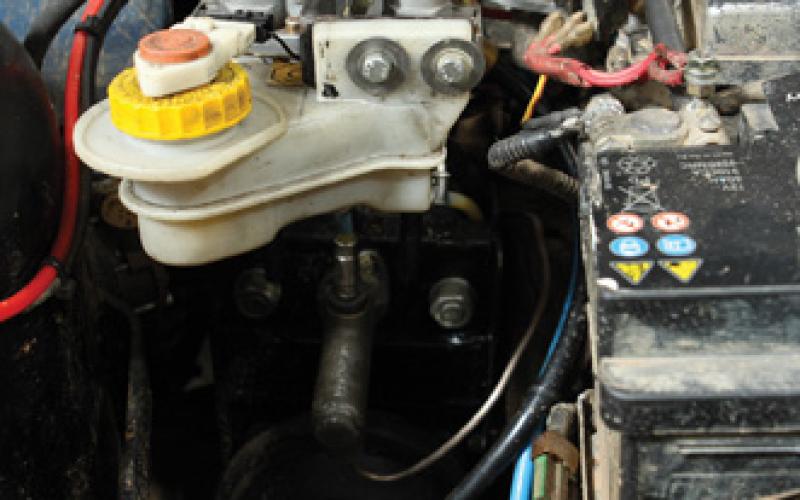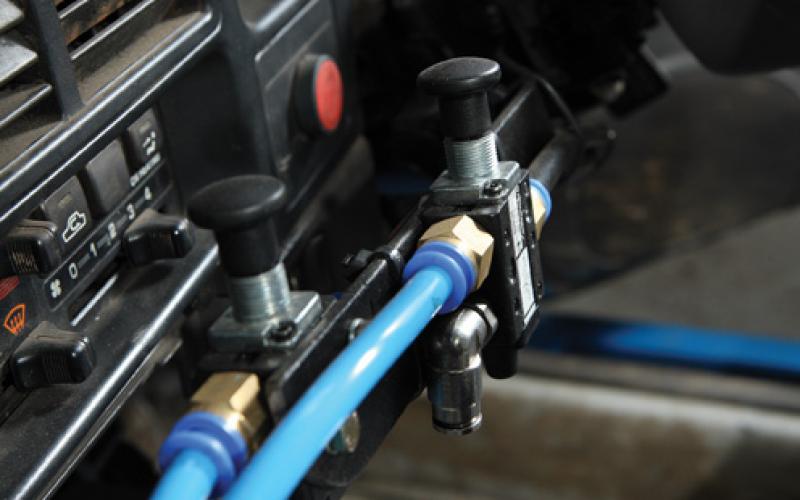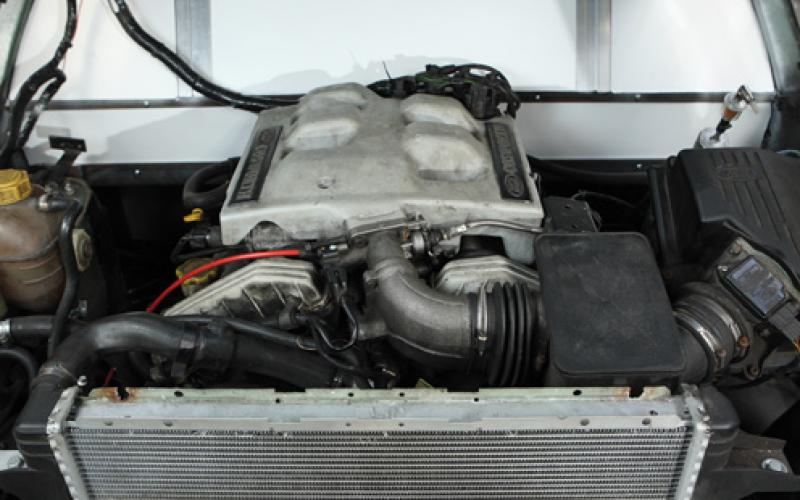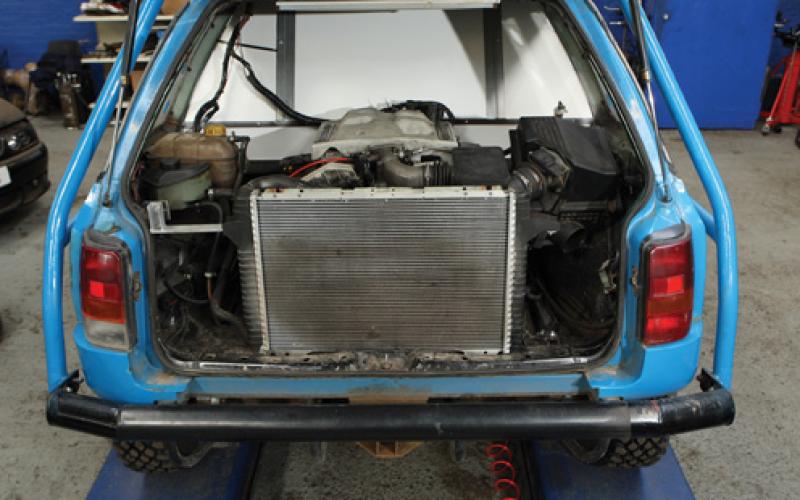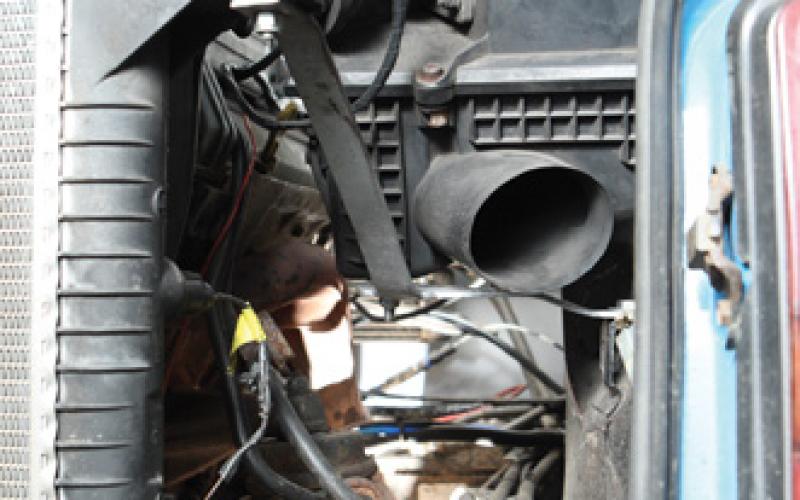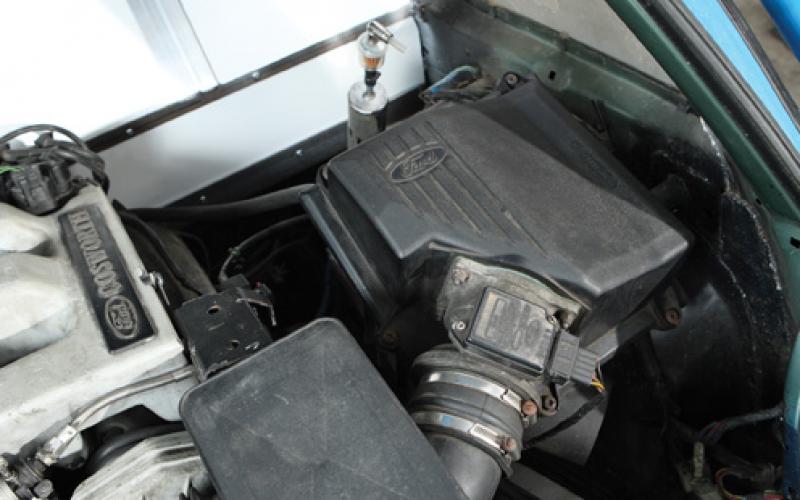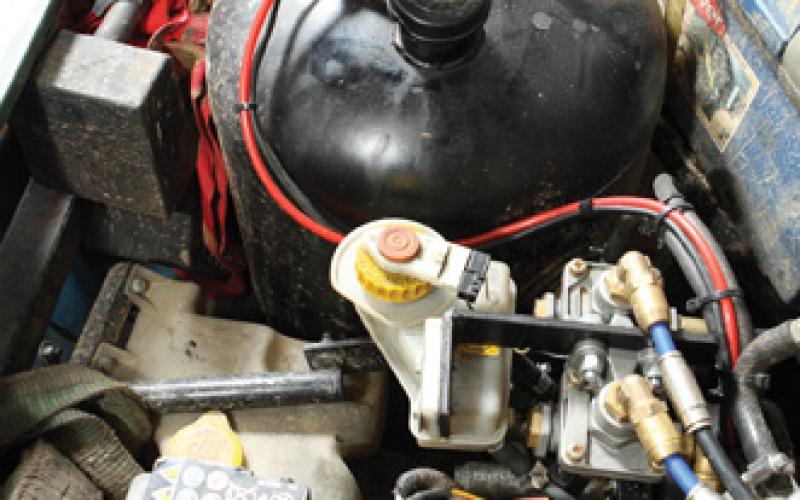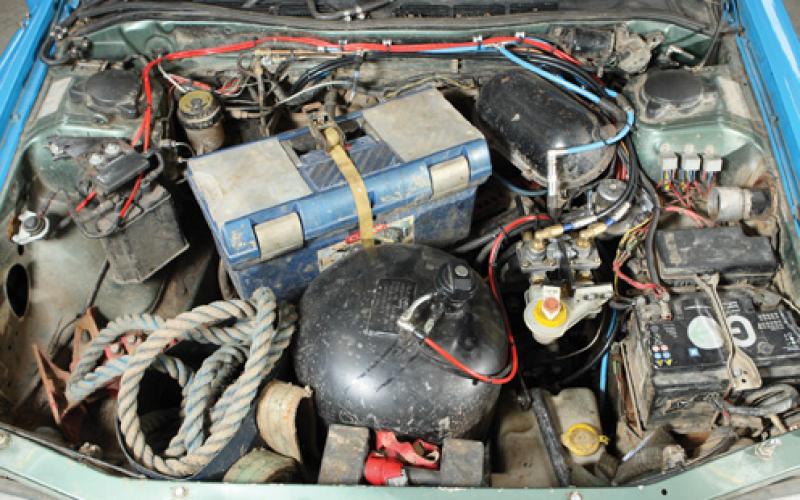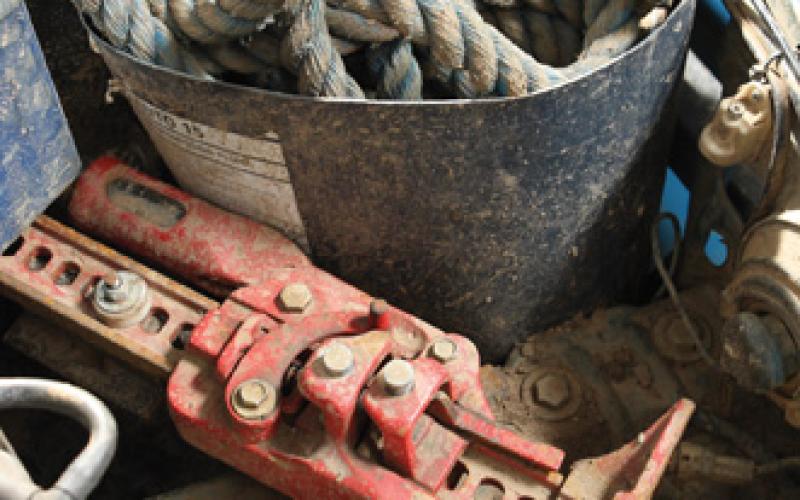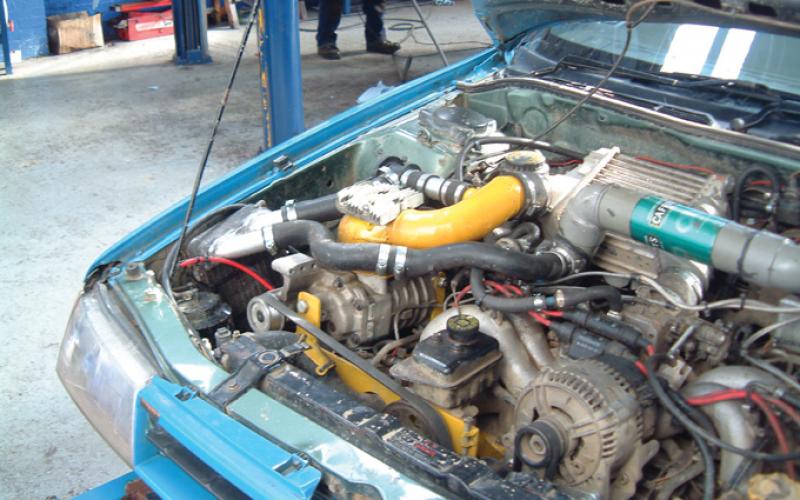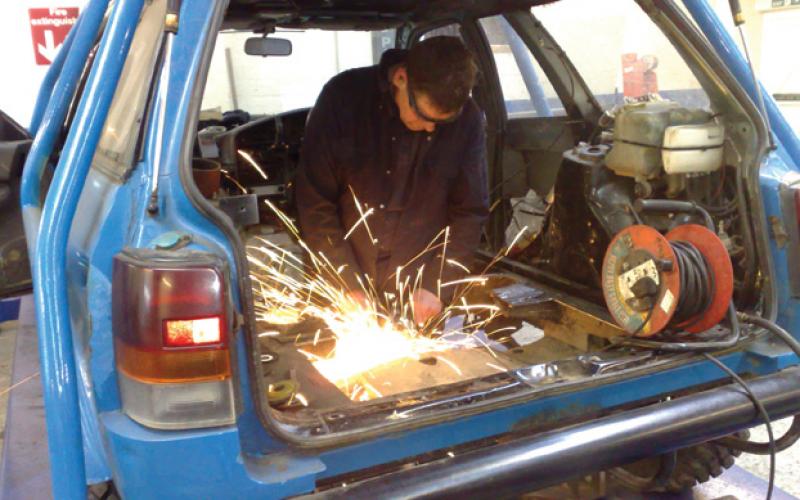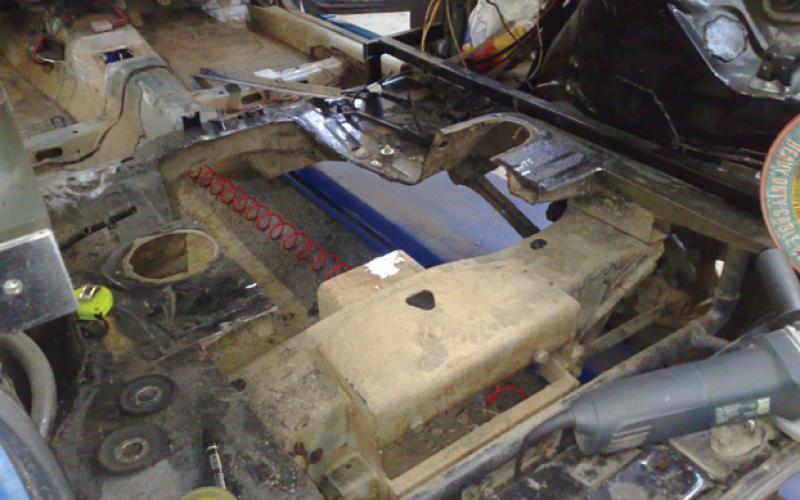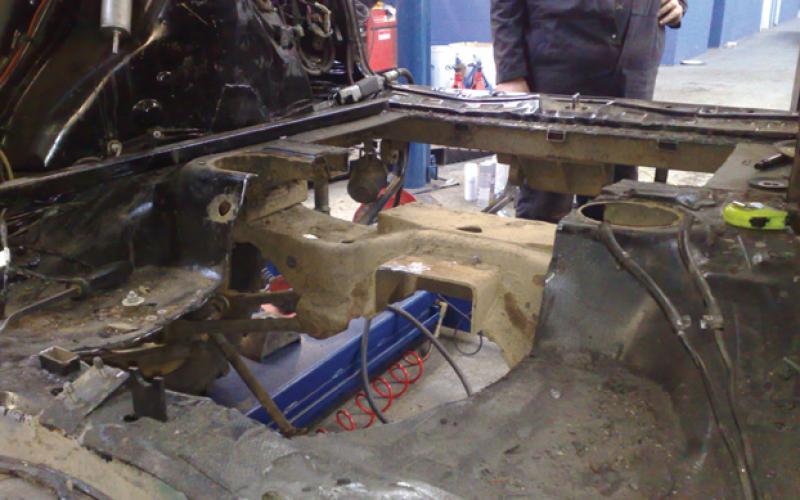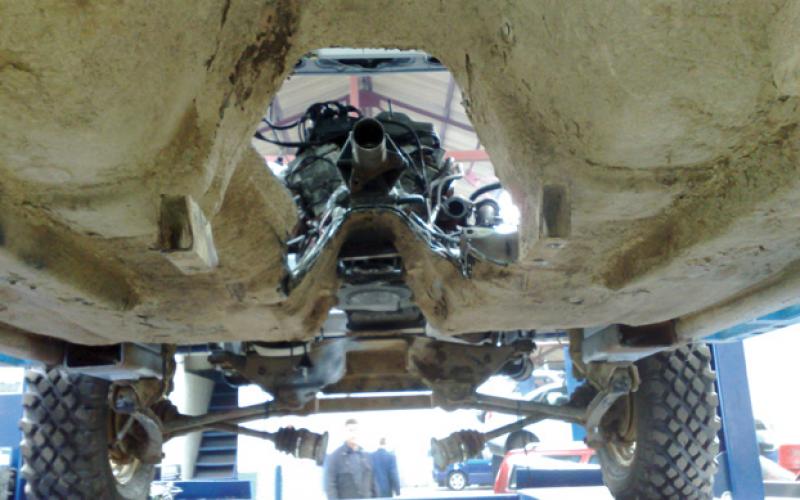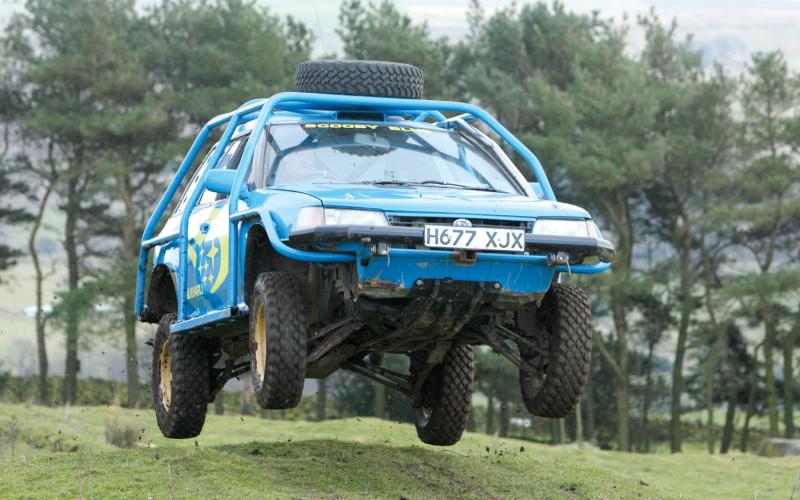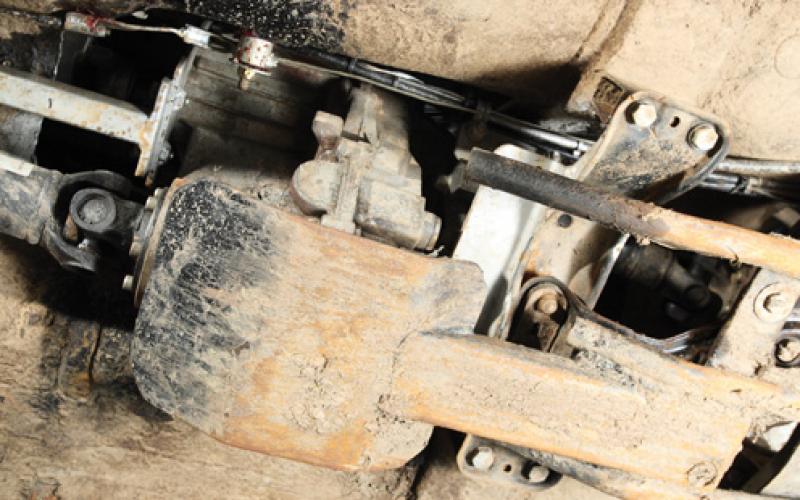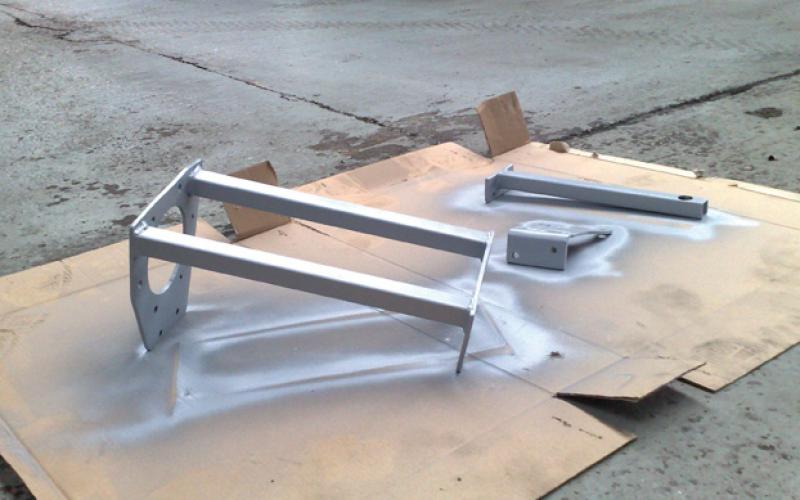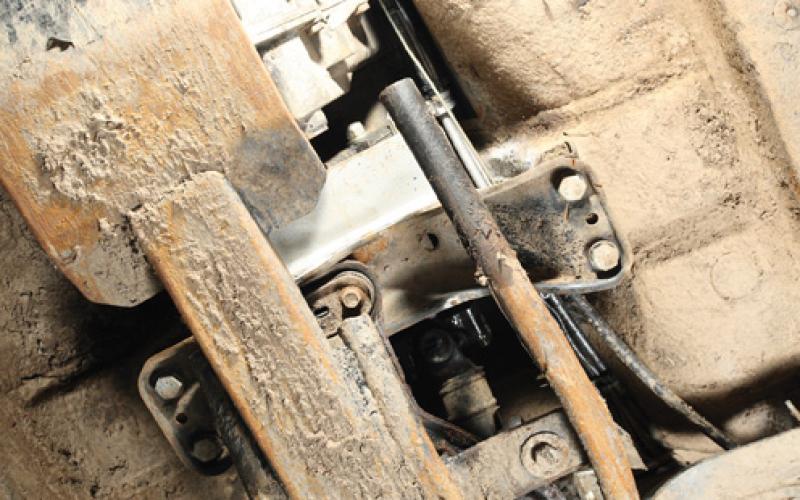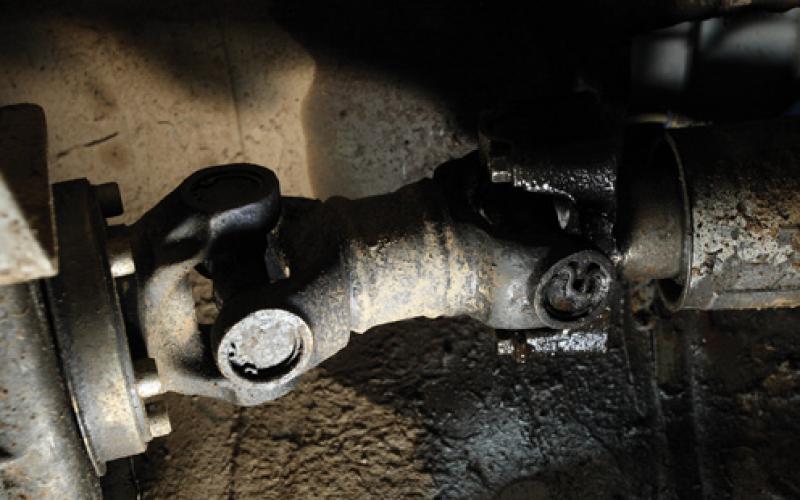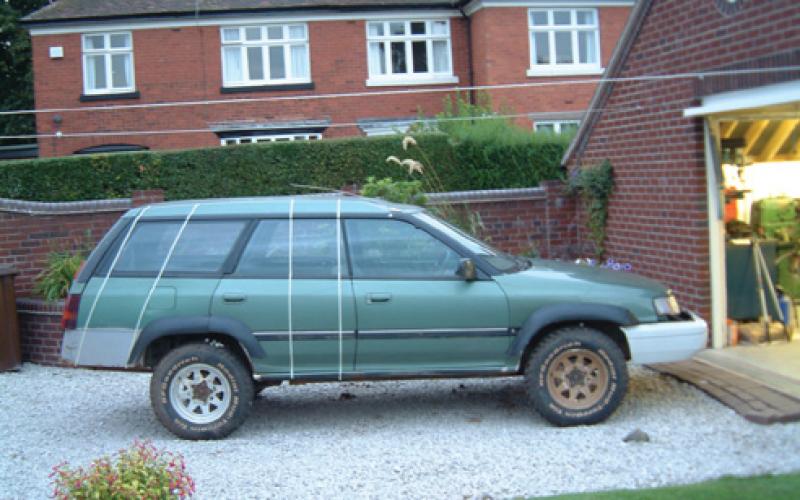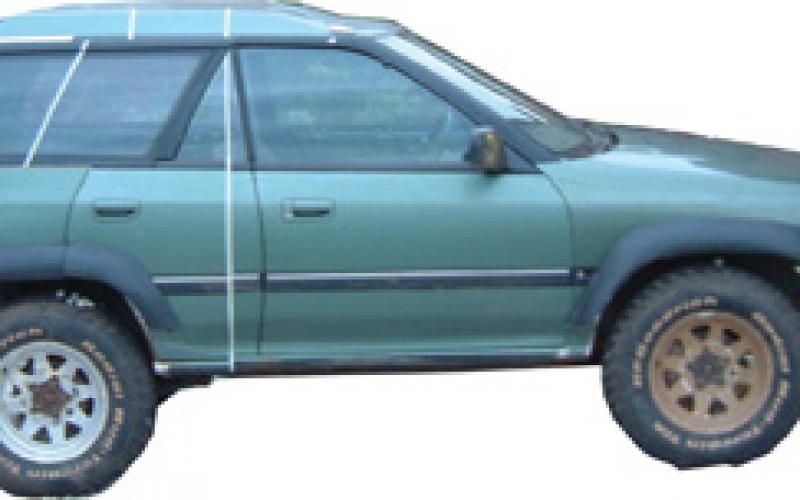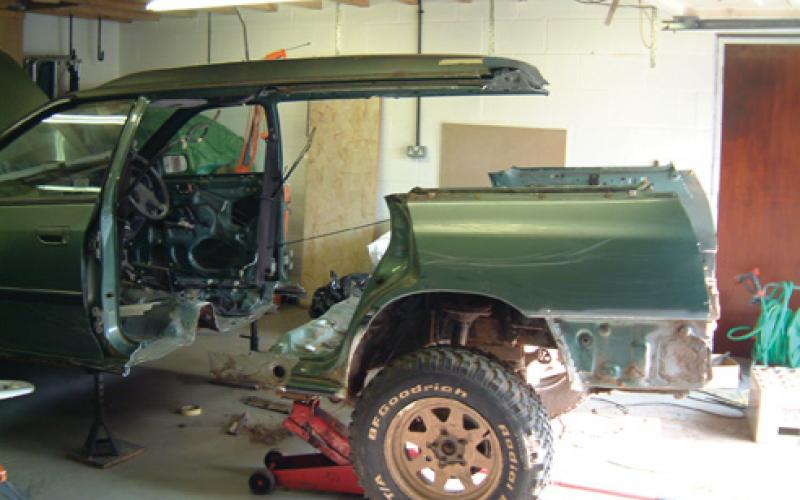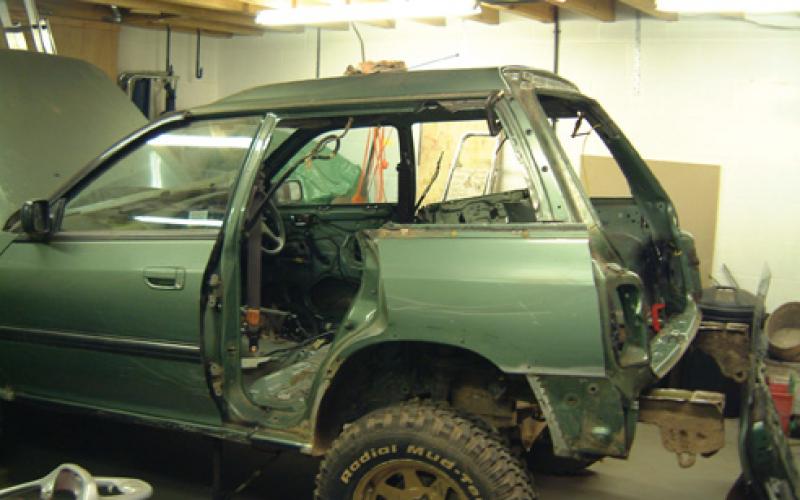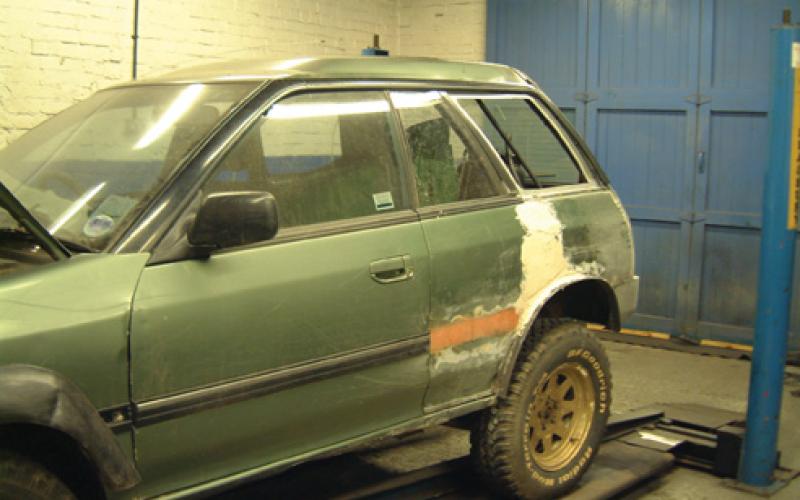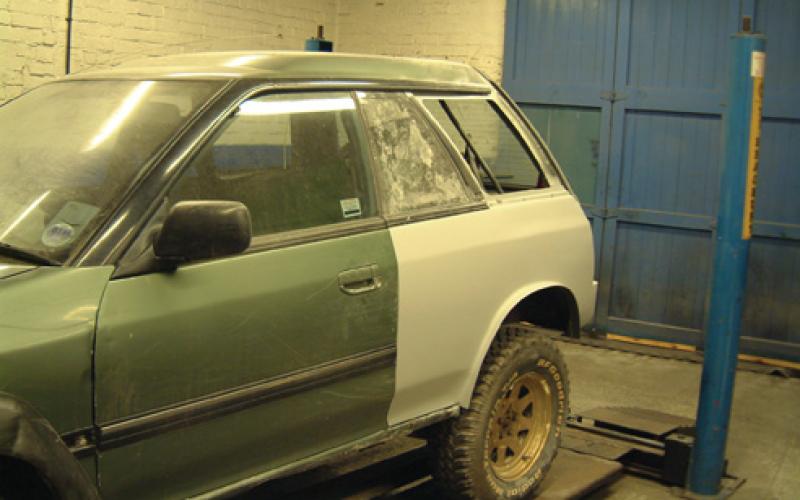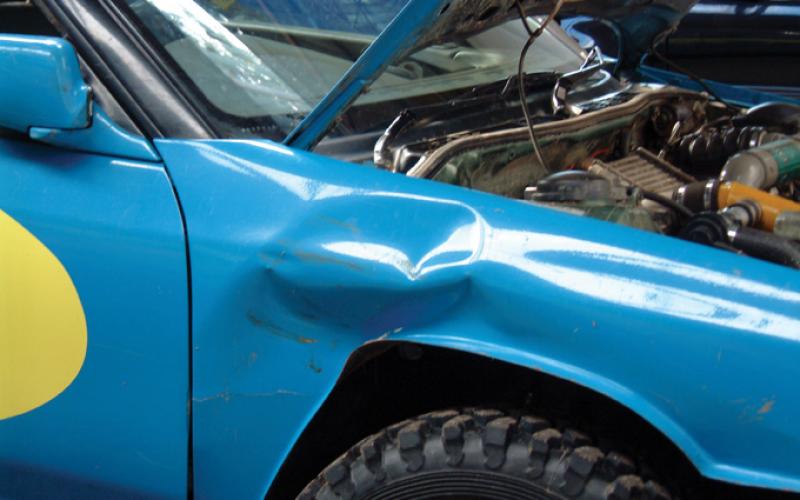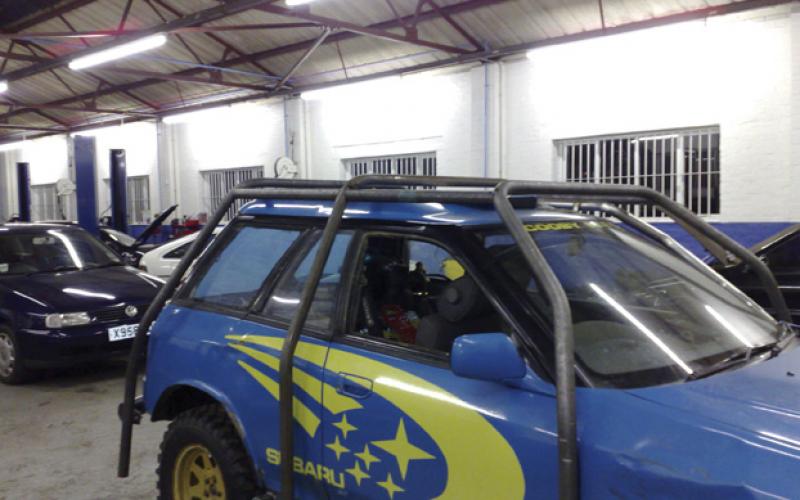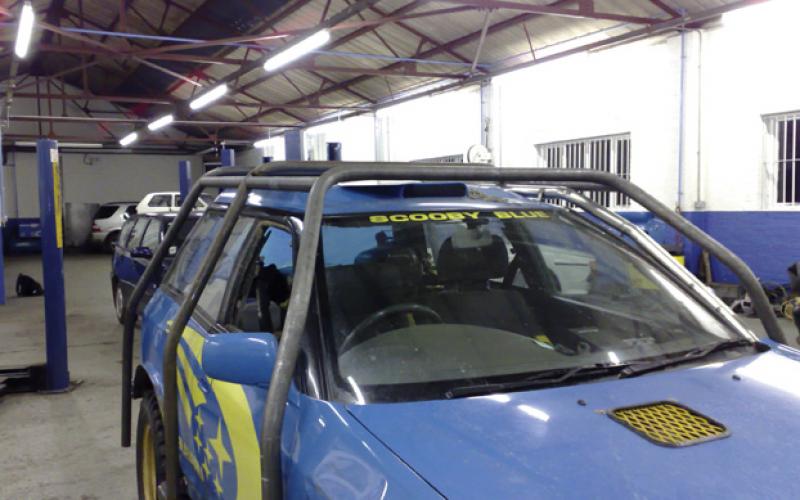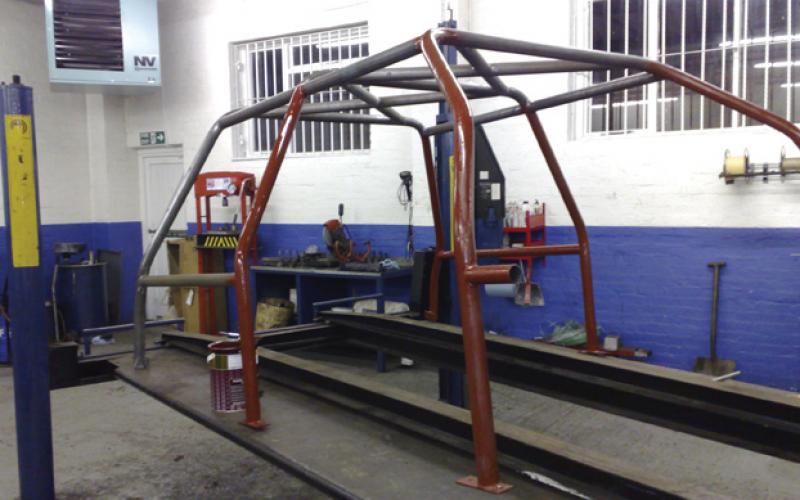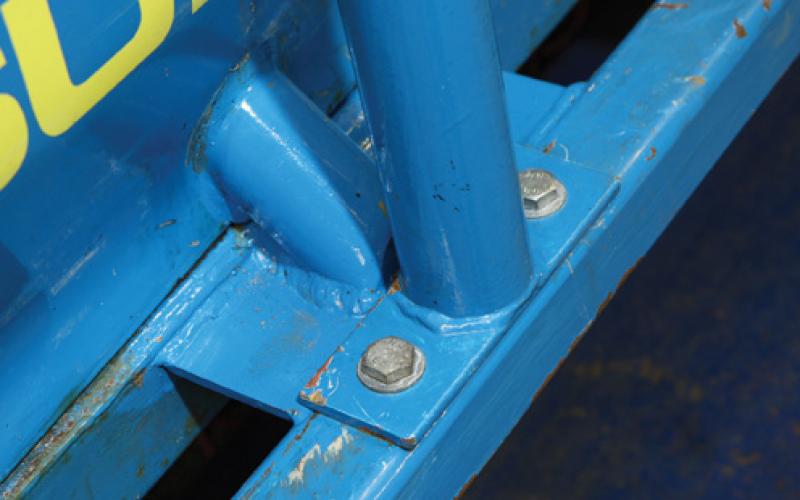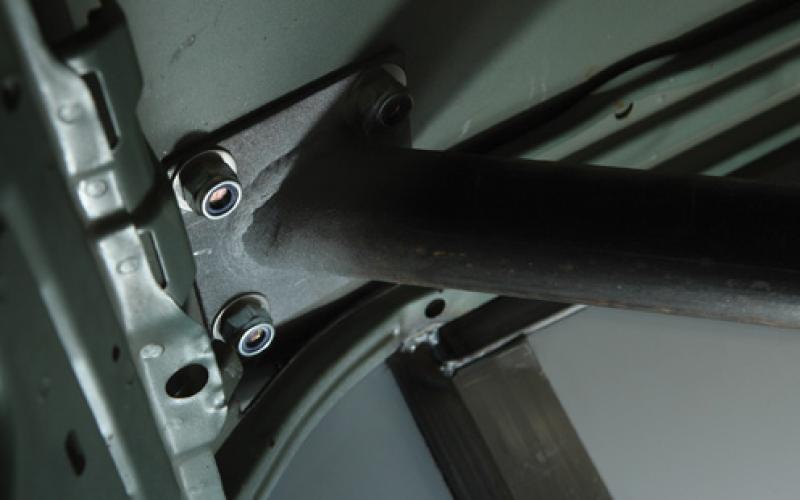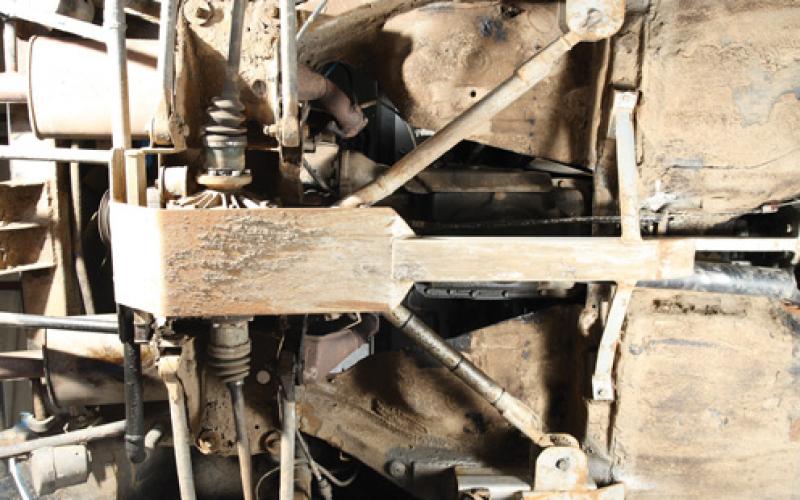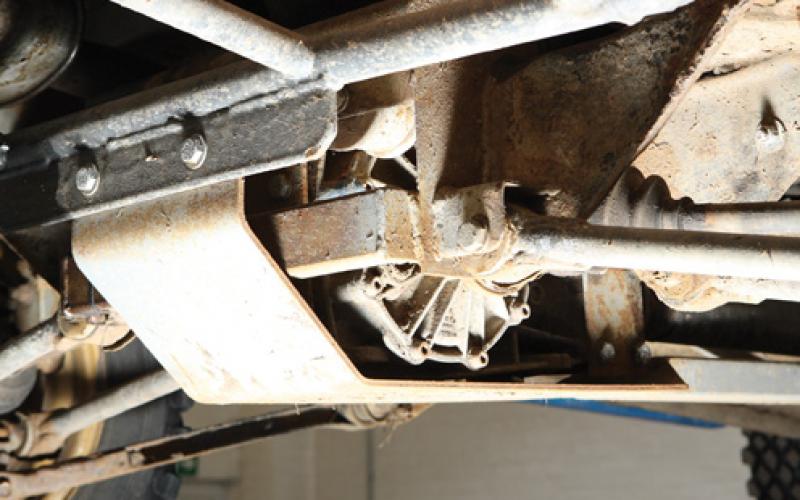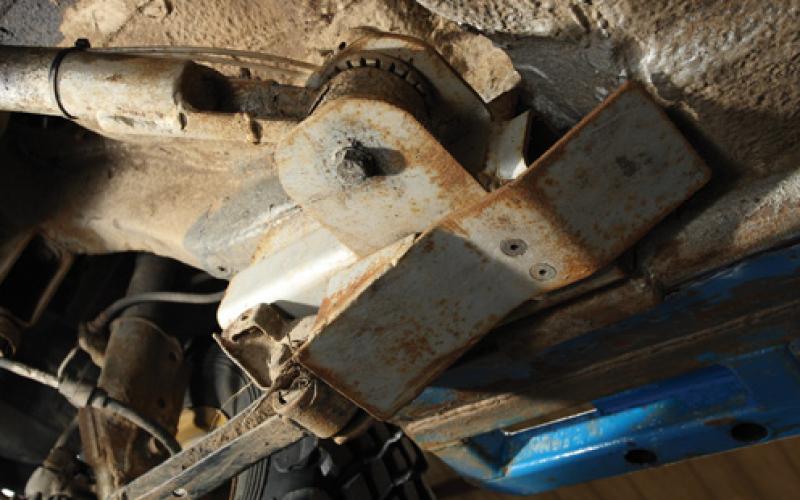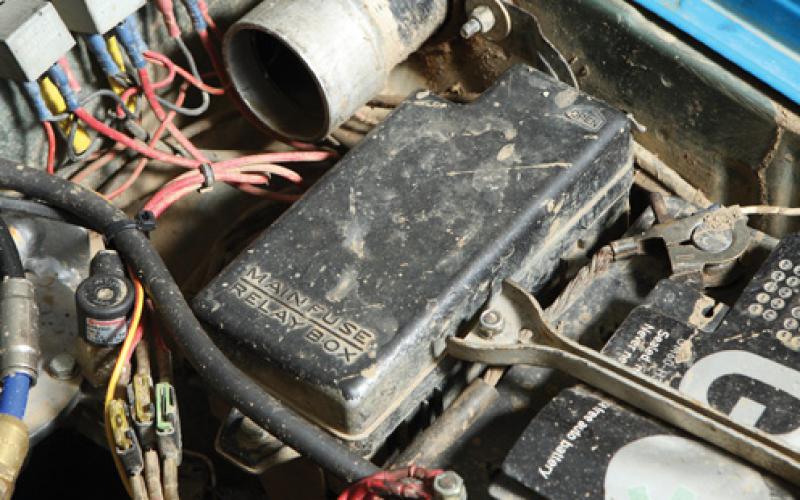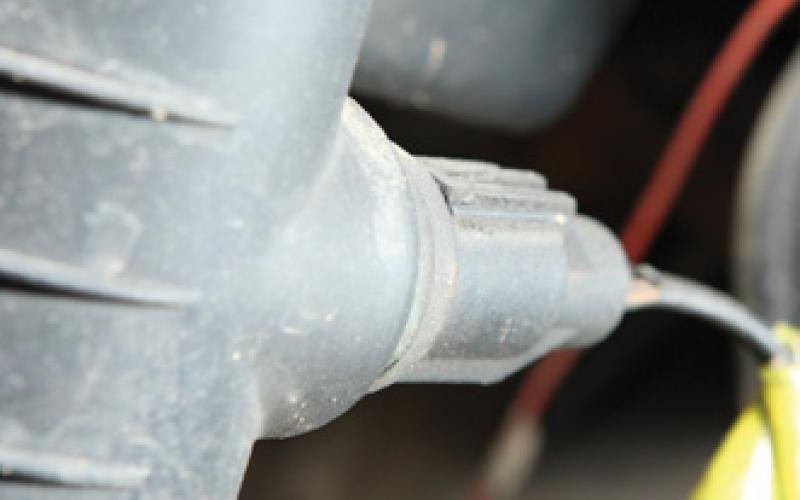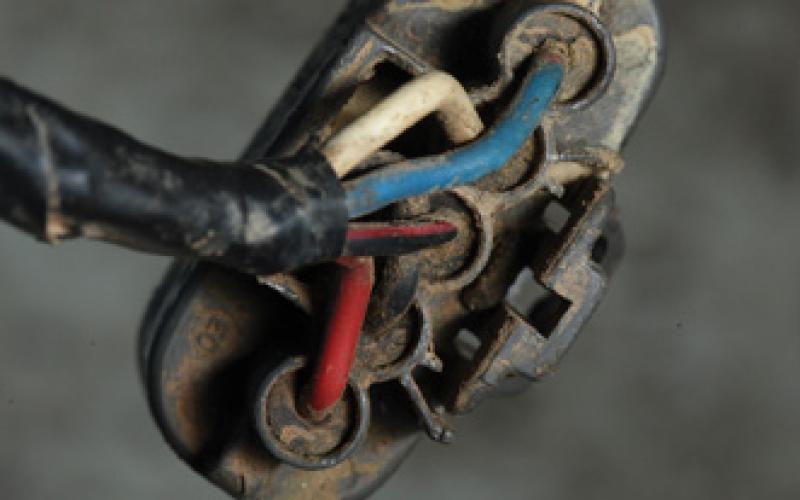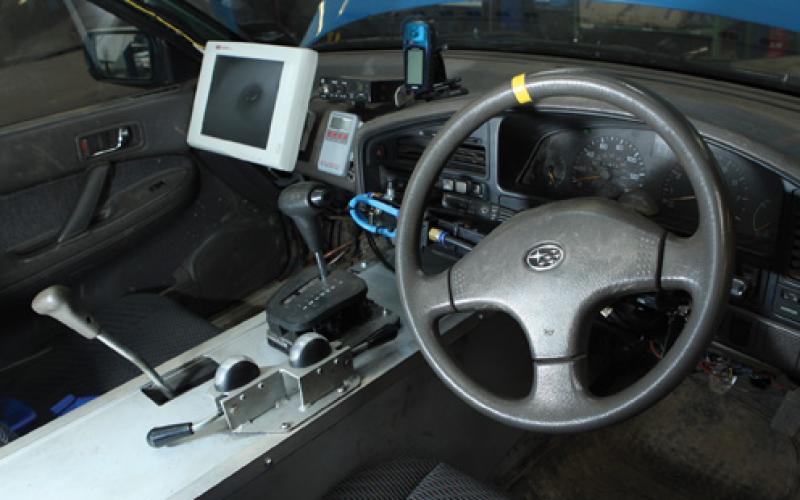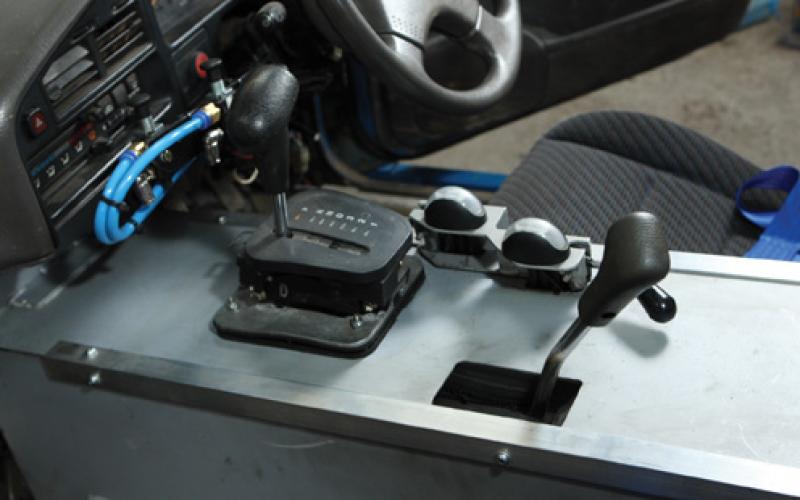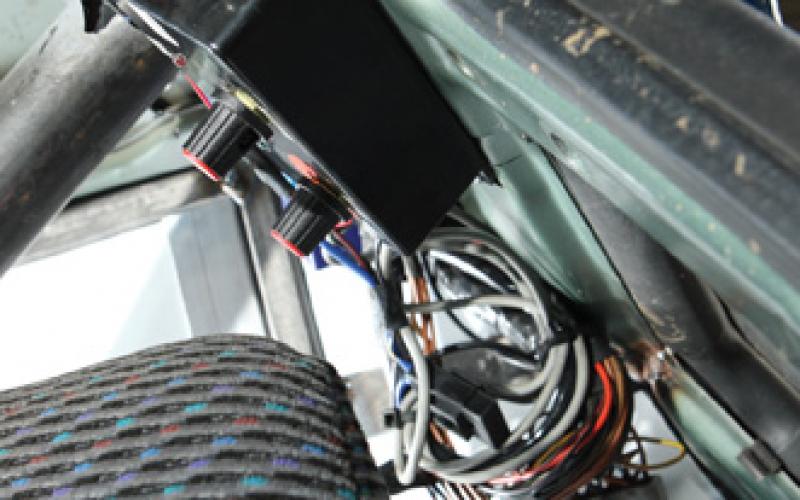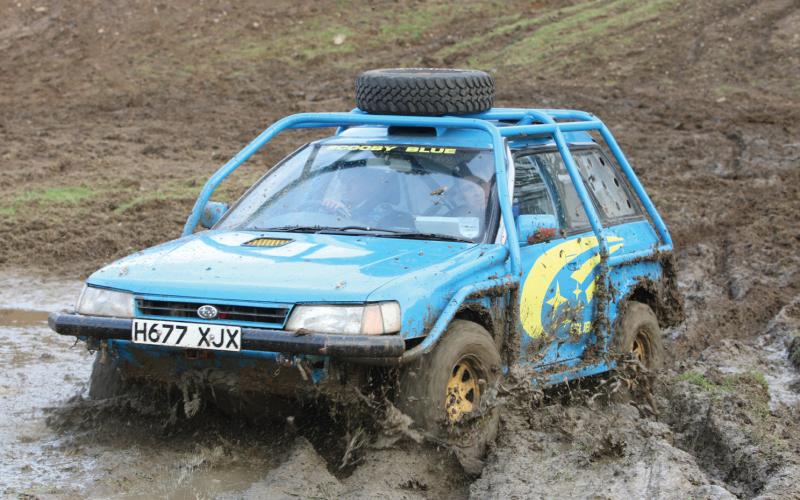Down In The Workshop, Something Stirred…
A Subaru Legacy that’s been turned into an off-roader might not sound very relevant to many 4x4 owners. But Andy Jackson and Shaun Hollis have created a vehicle that’s every bit as involved, cleverly thought out and technically interesting as some of the bespoke, big-budget off-roaders we feature in this magazine – the difference being that they’ve done it for next to no money using second-hand parts from a staggering range of vehicles. Settle down, then, for a masterclass in real-world 4x4 building…
Pay attention. Whether you own a Land Rover or a Suzuki, a Jeep or a Land Cruiser or indeed any other kind of 4x4, this is an article about your vehicle.
Yes, we know. It’s an article about a mad looking Subaru. But it’s much, much more than that. It’s an article about how a couple of normal people, who know what they’re doing in a workshop and have learned which end of a welding torch you hold it by, took an old Subaru Legacy and turned it into an RTV competitor and lane warrior to be proud of. It’s about the very many workshop challenges they faced in the process, and how they got over them – not by spending money, but by making bits, trying out different ideas and going through an endless supply of spare parts raided from broken vehicles to see what worked and what didn’t.
Last year, after we featured in-depth articles on Rob Tunnah’s MitsiMog and Tim Bentley’s Filthyboy, a few readers complained that these were vehicles they could never afford to build or own. Most appreciated that these were magnificent examples of off-road engineering that deserved attention in their own right, but there’s always a few. Anyway, the point is that if loadsamoney off-road vehicles put you off, this is for you.
Ironically, the people who moaned about these machines appearing in TOR have probably not even read this far. ‘I own a Land Rover, what’s a bloody Subaru got to do with me,’ etc etc. But for the rest of us canny old dogs, who know a good vehicle when we see one, meet Andy Jackson and Shaun Hollis.
Andy is a garage owner from Leek, and Shaun is a customer who’s become a friend and team-mate in both building and driving the vehicle. They use it for a mixture of RTV trialling and green laning – both of which are a long way from the day, six years ago, when they took it to its first playday for little more than a laugh.
‘A local garage owner kindly donated this old Subaru with a shot engine,’ says Andy. ‘It was very rattly, so we got a replacement for £125 from a local breaker, put it in and went out to play.
‘People didn’t think it would go anywhere,’ says Andy. ‘But with what little modifications we did, it was very surprising what it would do – for us as much as anyone else.’
These mods included a simple body and suspension lift, plus the addition of modified Suzuki rims carrying outsize off-road tyres. Enough to turn what’s basically an enhanced-traction estate car into an entertaining off-road fun machine, and that would be enough for most people. But for Andy and Shaun, it was just the beginning of an extraordinary project.
Since then, the vehicle has evolved, and evolved, and evolved. It’s been through a variety of engine, gearbox and transfer case combinations, lost a load of flab from its wheelbase and rear overhang and gained any number of useful additions, ranging from locking diffs (yes, on a vehicle with independent suspension…) to rally-sourced heat extraction. It’s had parts made for it from scratch, modified in various ways and scavenged from an extraordinary range of donor cars.
It’s also had next to no money spent on it. This is a vastly modified off-roader, yet it’s also a perfect example of how a good general level of workshop know-how, coupled with unlimited imagination, can yield a vehicle that money couldn’t buy. View this article as a step-by-step guide to building a modded Subaru, and you’ll be missing the point: read it with an open mind, however, ready to be inspired by the ingenuity, clever thinking and good old-fashioned trial end error that’s gone into creating a unique off-road vehicle, and your only problem will be how to get to your own workshop quickly enough.
Wheels and Tyres
We’ve mentioned the preparatory mods Andy and Shaun made to the vehicle prior to its debut as an off-road toy. When we say ‘prior,’ however, we’re cutting the term pretty close, because the welds on the new wheels barely had time to cool before it was being loaded on the trailer.
‘The wheels were a problem,’ explains Andy. ‘We were on standard Subaru hubs, and because of the suspension lift the tyres were fouling the legs. We used Suzuki rims to get more offset, but obviously you can’t go out and buy a Subaru to SJ adaptor. So we had some centres made to pick up on the Subaru hubs, then welded them into the rims.’
‘We were still doing it on the morning of the first playday, too!’ recalls Shaun. But if you’d expect the wheels to bear all the hallmarks of a rushed job, think again: they’re all balanced up properly, and Andy says they’ve proved themselves at speeds of up to 90 mph.
That was on the 195R15 Greenway Atacamas the vehicle now sports, though back in the early days Andy and Shaun simply lobbed a set of hand-cut tyres on it and made do with those. Another reason, perhaps, why they were so surprised by the Subaru’s abilities on that first time out.
Suspension
Making enough room for a chunkier set of tyres was clearly a stage one job, and as we’ve mentioned, the lift Andy and Shaun devised for the vehicle was actually instrumental in the need for its modified rims.
Both the body and the suspension were lifted, the former using spacers made from 60mm box. Simple, strong and effective, thanks to Shaun’s skills with the welding torch, which were also put to use in extending the bottom mountings for the suspension. Add in a set of home-made rear tie bars, mounted using turned nylon bushes, and you’ve already got a masterpiece of DIY making-do.
The lifted mounts provide about four more inches, with extensive plating to ensure that should they get bent, it’s because something serious enough has happened for mere suspension mountings to be the last of the team’s concerns. The same can’t be said for the front wishbones, which kept on getting bent. Since then, they’ve been gusseted with tube, which seems to have done the trick.
Subaru’s own coil springs have been retained front and rear; retained, but, in the case of those at the blunt end, now augmented by a set of VW Golf Mk IV units, which fit neatly within them. These help the Subaru units take the weight of a relocated engine, more of which below.
Shocks, too, remain standard all round: ‘We’ve blown one shocker in six years,’ reveals Andy, ‘which says a lot for the Subaru parts.’ They’re captive top and bottom, however, meaning there’s no capacity for dislocation – clearly an issue on a vehicle whose suspension was never designed to provide the articulation of a full-house off-roader.
Brakes
Something that doesn’t go well with a locked diff, unless of course you remember to unlock it first, is fiddle brakes. These work on run-of-the-mill Vauxhall Vectra calipers, but the way they’re actuated is far from normal.
‘We’d tried various methods,’ says Andy. ‘We’d tried single and double lever methods, but ultimately we ended up going with CO2 power. We used Fiat Punto 19mm clutch master cylinders mounted to an air diaphragm handbrake off a commercial vehicle, through two valves and air switches. They run off compressed air via a CO2 bottle – in time we may mount a compressor somewhere so we have our own supply, though it doesn’t use that much air anyway. It operates at about 90psi – when you flip the switch, it’s instant, it pushes the piston in the master cylinder and it hits the brake hard. It works very well.’
Something else that’s abnormal is the fact that on each rear wheel, the Vectra caliper is one of two acting on the same disc. That’s because the original inboard handbrake ‘lasts about five minutes’ in off-road conditions, so they wanted to replace it with something more rugged – but the fiddle system, being CO2 powered, wouldn’t pass the MOT as testers want to see a mechanical unit. ‘We put Rover calipers on top, with the handbrake working on them to make it road-legal for the MOT. Then we made some mounts to put the Vectra calipers on the bottom, so that we could keep the handbrake and fiddles separate.
Inside the cabin, meanwhile, another problem cropped up in that with the gear shifter and transfer lever, plus diff lock levers on the transmission tunnel and now a pair of fiddles projecting from the steering column, there was precious little space for the handbrake to go. Fortunately, a friendly customer came to the rescue with a part from the most unlikely of sources – a late-letter Mercedes. These had a foot-operated pedal and a release handle on the dash – the kind which on many current cars activates an electronic unit, but a few years ago was still linked to a good old-fashioned cable.
Did we say this was the most unlikely of sources? Forgive us. That would be the donor for the vacuum tank. ‘When we changed the engine (see below), that gave us a hydraulic brake servo rather than the vacuum type we needed. So we opted for the electric vacuum pump from an Audi A4, on a pressure sensor, and the tank from a 1959 Ford Anglia, which we had lying around!’ In the six and a half years during which this magazine has been published, we’re fairly confident that there can’t have been many more surreal sort-outs than that…
Original Engines
We’ve already mentioned that the first thing Andy had to do was hook out the blown engine which he got with the vehicle and replace it with one that didn’t sound like a bag of spanners. This was something he got quite used to over the next couple of years, as Subaru’s 1.8-litre, 16-valve flat four proved to be less than enamoured with the sort of treatment it was getting.
‘We went through three,’ recalls Andy. ‘The bottom ends kept knocking out – they weren’t terribly strong, though at the same time we were doing stupid things with it – it definitely wasn’t as nature, or Subaru, intended!’
The original replacement engine was on carbs, but this ultimately gave way to an injected unit – and that’s when the fun really started. The engine itself was fine, but its electronics started causing problems – at which point Andy did some shopping around for spares, and rapidly concluded that they were way too expensive.
His solution was to create a system based around the Bosch K-Jetronic injection seen on many GTis. This was made up from a variety of Audi and VW parts, augmented by manifolds turned up on the lathe. ‘That ran absolutely lovely, as they always do,’ says Andy. ‘It’s such a simple system to put on anything.’
‘You can stand it vertical and it still runs,’ adds Shaun. With such levels of praise from both halves of the team, you’d think that they’d leave well alone, not try to fix what ain’t broke, and probably some other clichés besides, but then someone came along with a supercharger from a Mini Cooper S and suggested putting it on the Scooby engine. ‘So we said why not…’
Here’s why not. ‘We spent ages manufacturing brackets to hold it all, all the pulleys and drive, and put it on. Straight away – major pinking trouble.’
Not to worry, there was an answer, in the shape of water and methanol injection. Yes, this really is a low-budget fun machine. ‘It was developed for some German aeroplane or other,’ says Andy. ‘You inject 50% methanol and 50% water – it stops the pinking and raises the power. We didn’t fancy buying a kit for £400, though, so we developed our own system using compressed air in a fire extinguisher, injected through a 0.6mm nitrous jet and a pressure sensor and pulsed in by a relay. That went well, until it blew up…’
When he says ‘blew up,’ that’s exactly what he means. ‘It found a tooth and broke it off, that found another and broke it off too… The engine and gearbox went together, quite spectacularly and with a lot of noise. So that about killed that!’
Current Engine
If you’re thinking they should have stuck at the K-Jet stage, and that the Cooper blower was a twist too far, there’s a strong chance that Andy might have agreed with you. Especially when he went looking for second-hand parts, only to find that with scrap making such good money at the time, anyone with a wrecked engine or gearbox had long since weighed it in (if it hadn’t already been nicked in the night, of course).
That meant looking at new parts, which in turn meant looking at any other available option. ‘When we blew the engine up, we’d melted the pistons and done other damage besides, and the cost of the parts was horrendous. The gasket set alone was about £300. It just wasn’t happening.
Especially not when it was possible to buy an entire Ford Granada Scorpio for a mere £200. No, not to drive off into the sunset in… this was a scrapper, but a whole one, complete with ECUs, wiring loom, gearbox and engine. And that engine just happened to be a 2.9-litre, 24-valve V6 Cosworth.
‘We’d actually bought the Granada about three years previously,’ says Andy, ‘with a view to using the engine. One of the things we liked about the Subaru engines was that they would run under water – the spark plugs, leads, the lot, it could be totally under water and it would keep running. It has wasted spark ignition, which just doesn’t seem to be bothered.
‘That was one reason for going for the Cossie engine. We didn’t want anything with a timing belt, obviously because of water getting in the covers – we had loads of grief from that on the Subaru. And we wanted wasted spark, where it’s firing two cylinders at any one time, doing away with the distributor – which is where petrol engines’ vulnerability in water comes from. With that and a timing chain, we had a choice of Cosworth, Golf VR6, or some of the BMW engines. We just happened to come across this one first – and now seemed like the time to use it!
‘We started thinking about deciding which end it was going to go in. That meant lots of measuring, lots of nights pondering, head-scratching…
‘Finally, we decided it had to go in the back, simply because it was too physically tall to go in the front. We wouldn’t have been able to see out the windscreen – literally, it would have been like a drag car off the funny strip, with the engine poking out the lid!’
If changing a car from front to rear-engined sounds like a scary decision to make, imagine how the guys’ hearts must have been beating when the time came to take the first cut. ‘We attacked it with the grinder and cut a big square out of the floor. That took a lot of bravery – we’d definitely reached the point of no return!’
The engine’s final position was a little higher than Shaun and Andy had hoped, but having craned it into position they were only able to lower it so far before the rear diff got in the way. As we’ve already mentioned, the extra weight in the back of the car has prompted Andy to double up its rear springs, but in addition to this Shaun fabricated another set of extensions to lift the body by another 60mm. ‘If we hadn’t done that, we’d have had to mount the engine so high it would have been top-heavy in the body. It’s still higher than we’d have liked when we started out, but by lifting the body we were able to mount it as low as we could.’
That of course is an issue they were able to predict while planning the installation, and so was that of cooling. The Granada donated its radiator, which thus could be trusted to have sufficient capacity for the engine, but of course it was designed to keep the V6 cool with the benefit of ram air. Not that Cosworths have a habit of overheating when stationary, of course, but the point is that in the Granada, when the engine was being worked, it’s because the vehicle was moving – now, in the Subaru, it could be getting a proper pasting at 1mph, and not only would the radiator be denied ram air because of the lack of speed, it wouldn’t be getting it anyway thanks to its position just inboard of the tailgate.
Sucking air in through fans is the normal solution here, and that’s exactly what the standard unit does. Shaun and Andy cut out the number plate panel, moving the plate itself to the right and out of the way of the necessary airflow, and put an aperture in the back for the radiator to pull air through.
This helped, but the engine compartment was still getting very hot, with no through-flow of air to help cool the block. ‘Somebody gave me a fan off a rally car to put in the roof and get some heat out,’ says Andy. ‘We operate it with a little control made by a local electrical guy, so we can fully adjust the temperature at which it comes in and how long it comes in for. Together with the engine’s own fan, that seems to keep the temperature about right.’
Fuel comes from a front-mounted LPG tank, chosen because of its extra thickness compared to a standard petrol unit. The idea is that it can put up with much more serious abuse, and that the risk of it rupturing in response to the sort of impacts that regularly go through the area in which it’s mounted is therefore much diminished. The fuel pump is submersed in the body of the tank, which brought one outing to a premature end when the feed blew off. Since then, they’ve soldered on a nipple to prevent it from coming loose again.
At the other end of the process, waste gases are blown out through a pair of VW Golf centre boxes. As Andy says, the engine’s position means there’s not much room for pipework, but it was still necessary for the system to contain enough room for the lambda probes required by the Cosworth’s engine management system. Proof that this is no straight-through lash-up comes as soon as the key is turned – you expect not to be able to hear yourself think, but while the exhaust is hardly quiet it’s also by no means harsh.
Transfer Box
The Cosworth engine went in complete with its automatic gearbox, replacing both the Subaru units which had been annihilated in the big meltdown. That meant curtains for the cut-down Land Rover transfer box, however; this had worked fine as an adjunct to the Subaru’s standard four-wheel drive system, but with the Granada box it was now going to be necessary to run a separate unit.
Fine, but sourcing the right box wasn’t as easy as you’d expect. ‘We found an old Bedford TK from the army,’ says Andy. ‘Somebody said it was a nice small unit, but when we got there it was massive, absolutely huge. So then I got one from an old Austin K9 from the 1950s, and that was unbelievably heavy.
‘Then somebody popped the question of a Chevy Blazer box, because it was separate to the gearbox when it’s pulled off the shaft, it’s chain-driven and it’s self-contained in its oil. So we went and found one, but because it’s separate, of course, we still hadn’t got the splined bit to go into it from the gearbox. But at that point, the bloke kindly got his grinder out, chopped the mainshaft off and handed it over – still for the same £40 we’d agreed on for the transfer box!
‘Then we were able to have an adaptor machined to go from the spline to the rubber doughnut drive off the back of the Cossie box. We still had to get the gearbox and transfer box in the same line to take the drive off the mainshaft, though – we had to make it as if it was all one unit.
‘We fabricated quite a fancy cradle to take the box, using two rear gearbox mountings. That gave us the engine bolted to the gearbox and the gearbox bolted to the transfer case, with a little cushion mounting under the box and then the main one at the back holding it all up, which Shaun fabricated.
Actually, it wasn’t as straightforward as all that. With the limited room available in the transmission tunnel, the transfer box had to go on its side to fit. This of course meant drilling a new oil plug and filler in the casing, and modifying the breathers.
‘We mounted it up and had two propshafts made by GKN in Leek,’ continues Andy. The front one is extremely short and has quite a diagonal on it, and we had to grind quite a bit out of it to gain the clearance we needed. At that point, we were able to take the car out on the road for a test-drive… and it almost shook itself to pieces!’
The problem was that front prop, whose lack of length meant it was basically acting like a solid bar between the diff and the transfer box. Seems like the rear gearbox mountings weren’t made to cope with this much grief. ‘We then came back and altered the transfer box mounts,’ says Andy. ‘I used two engine mounts from a big-block Chevy Corvette Stingray, which I happened to have. Obviously, they’re made to hold a big motor, and they sit really tight. That made it a lot better.’
Something else that’s a lot better now is the life expectancy of the rear driveshafts, which were letting go on a regular basis prior to the arrival of the auto box. Andy puts this down to a combination of factors: the cushioning effect of the torque converter, which takes away the snatch that can be associated with manual transmission, is certainly one. ‘If we had it spinning,’ he says, ‘and suddenly it got grip, it would just go bang. It was shearing them off inside the CV joints at the end of the spline.’
But there’s another reason for the shafts’ new-found longevity, which comes as a result of something altogether more fundamental. The Subaru’s body and chassis have had an ever-changing existence, even by the standards of the rest of the vehicle, and after the engine went in the guys subjected it to a lengthy programme of weight-redistribution measures in a bid to get it as well balanced as possible.
‘We borrowed some scales from a local hot rod guy,’ says Andy, ‘and found that the vehicle was about biased about by 45% to 55% front to rear. It was about 120 kilos light at the front, so as it was accelerating obviously the front came light and we didn’t get much traction out of the wheels, even with the lockers on.
‘So we moved everything we could that had any weight into the front. There were some heavy components that we could put there, but also our tool box and high-lift jack – even our ropes are there! Even so, we still had to fill the front bumper with 85 kilos of very fine sand to act as ballast and get the weight as far as we could over the front. That’s made a big difference to the traction we can get, and since we did it we haven’t had a single driveshaft go bang, either.’
Chassis and Body
More on those changes that have been wrought to the integrated body and frame throughout the vehicle’s life, then. The first, and most significant of these came early on, when it was shortened by a total of 29 inches. Sixteen of these came out of the rear overhang, while the remainder, which the arithmetically gifted among you will have worked out came to just over a foot (a baker’s foot, you might say), was lost from the wheelbase by chopping it down the middle of the rear doors.
‘We didn’t cut the roof to start with,’ says Andy. ‘We unpicked the seam on the floor, cut out thirteen inches and re-welded it. The roof was left to overhang with the rear tacked in place, then cut off and then fully welded. What was left of the rear doors were then welded shut, adding yet more strength to the vehicle’s body.
Andy’s happy that by doing it this way, rather than just hacking his way down the middle of the vehicle and welding it back up, he’s managed to retain critical elements which give rigidity to its monocoque frame. ‘It’s as it should be,’ he says, ‘which is good for strength and safety.’
Roll Cage
Furthering both these causes is a moderately epic rollcage made from MSA-spec seamless tube and mounted to no less than ten points on the vehicle’s superstructure. Like the steel itself, all the flanges and fixings are as specified in the Blue Book, though Andy and Shaun didn’t pay too much attention to the regulation design as they knew what they wanted to achieve and weren’t looking to get the nod from any scrutineers.
‘We seem to be attracted to trees,’ explains Andy. ‘We’ve picked up quite a bit of body damage, so we decided we’d build ourselves an external cage, for body protection and also for safety. If you look down at the top of the roof, we’ve cross-braced the front and rear sections so that any impact is transmitting its force to the centre of the cross. I can’t see that ever moving… if it does, it’s weighing-in time!’
Since then, the cage has been strengthened yet further with the addition of an internal cross-brace. This runs through the roof and is flanged to the external sections just behind the doors; Shaun reckons it’s probably been enough to take the vehicle beyond the two tonne mark overall, but the weight it adds is nothing compared to the extra rigidity it provides.
The internal brace was installed just a few days before we visited to take these pictures, as was a bulkhead between it and the engine. This was made from a steel frame and a flat panel made from Alucore, a composite aluminium material with a honeycomb section giving it enormous strength for its weight. It was installed mainly to cut down on the amount of noise ringing around the cabin; it wasn’t yet fireproof when we visited, but sealing it up was near the top of Shaun’s to-do list.
Protection
The cage’s central hoops, whose job it would be to do the bulk of the weight bearing in the event of the vehicle going off on a big one, are mounted to a set of exceptionally heavy duty rock sliders. ‘We totally took the sills out,’ explains Shaun, ‘and fabricated new sills using 60x40 box, which is fully welded from the side and underneath. We then used steam pipe to create rounded edges rather than flat ones, so it acts more like a sledge if you hit anything. Then there’s 2mm plate from there to the outer sill, so that’s a U-section on both sides. We mounted the rock sliders off that, in 50x50 box section, and the cage is mounted off those.’
The amount of work Shaun put into fabricating the rock sliders gives you some indication of how far it’s been necessary to go to protect the vehicle’s underside. Most off-road projects go a long way to avoid ground contact; Andy and Shaun accept that with the Subaru’s limited clearance and articulation, it’s inevitable, and instead concentrate on ensuring that when it happens, it doesn’t damage anything or get the vehicle hung up or snagged.
Taking a look underneath the vehicle, you’ll see a pair of skids made from steel plate and solid reinforcing bar. The leading one of these protects the transfer case, while the longer of the two has been moved from its initial position under the engine in the front to… under the engine in the back. This leads with about two feet of bar, and with nothing to catch on the ground it allows the vehicle to ride over obstacles. ‘Being independent,’ says Andy, ‘if it does drag on anything the suspension will drop, and it’ll still pull itself over. We tend to leave a line in the mud where we’ve dragged ourselves over – it’s a bit like an inverted ski.’
Further protection comes from a pair of bumpers which started life as farm gateposts. Farm gateposts, should you be wondering, are made from 90mm diameter steel tube with a 4mm wall thickness; if you’re going to have an accident involving a Subaru, do try not to make it this one. While the front bumper is doubling up as a ballast holder with its load of sand, its counterpart at the rear is carrying a tubular frame designed to let the vehicle slide off rock ledges without turning its exhausts into a pair of crispy pancakes. This runs down to the back of the engine skid plate, to which it bolts just astern of the rear diff.
Wither winches?
It may have occurred to you that instead of stuffing the front bumper with 85kg of dead weight, Andy and Shaun could have achieved the same effect quite usefully by lobbing a winch on top of it. You’d not be the only one; it’s such a blindingly obvious idea that even the man from TOR thought of it, but there’s a very good reason why the Subaru remains winch-free.
‘It’s something we have looked at,’ admits Andy. ‘But to be honest, with the sort of things we’re doing, we’ve never needed a winch to pull ourselves out of trouble. If we add one, it would be hydraulic, and it would be on some kind of quick-release couplings so we could move it from front to back – because if you’re talking about two hydraulic winches, plus your Plasma rope, you’re blowing a lot of money.’
Electrics
For this reason, the vehicle is unlikely to be pushed beyond its current electrical system, which is very nicely charged, thank you, by the standard 90-amp alternator from the Cosworth. That’s more than could be said for the original 50-amp Subaru unit, which was so far off the pace that the engine’s revs would drop away when Andy switched on the headlamps.
Actually, that’s a bit unfair, because with a rally-style light pod tucked away in the workshop on a second bonnet, the headlamps we’re talking about deliver a potential 700W of lighting on full beam. Andy uses this for laning at night but takes it off for trialling, reasoning that he ‘can’t afford to stuff it into a tree.’
Anyway, the old Subaru unit was initially replaced by a set-up featuring two alternators which didn’t work the way Shaun and Andy had hoped. Hence the arrival of a 110-amp unit from a Volkswagen Passat, which did the trick nicely until the Cosworth came along.
Not that it was all comfort and joy when the new engine went it, for a couple of good reasons. One is that its location in the back of the vehicle meant there was too much voltage drop for just one battery to be able to cope, meaning it was necessary to double them up. Not a major pain, though, of course; for that, imagine only being able to get your hands on a wiring diagram with no colour coding…
As a result, Shaun and Andy had to meter out every single wire from the ECU pins, making it a lengthy and thoroughly tedious process to sort out the loom. Having got the job done, however, they at least had the satisfaction of knowing that with a Subaru fuse box, the system was about as waterproof as it’s possible to be. ‘All Subaru electrics stand total water submersion,’ says Andy, ‘as virtually every wiring connection is rubber sealed.’ As proof, he points to the fact that after everything it’s been through, the vehicle’s electric windows and mirrors still work immaculately.
Inside
Looking at the vehicle’s exterior, you might be expecting it to be rough, chaotic and full of mud on the inside. That’s a massive generalisation, of course, based on the state of all too many oddball one-offs, but actually it’s tidy, well laid out and presented with plenty of attention to detail.
Driver and passenger alike sit in Honda Civic seats, for example, chosen because they’re just narrow enough to fit in the spaces left either side of a wide transmission tunnel which, as well as the gear shifter and transfer lever, also houses the diff lock levers. Both crew members are held in place by three-point harnesses, which allow enough upper body movement to let the driver reach forward and operate the fiddle brake located to the left of the steering column.
The navigator, meanwhile, gets a full GPS system to play with. This uses a Panasonic Toughbook laptop, which is mounted in the back and, drawing power from an inverter runs via extended cables to a 10-inch TFT screen on the dash. Loaded with Fugawi maps and taking its data from a hand-held Garmin receiver, it makes all the difference when the guys are away exploring. ‘It has pin-point accuracy,’ says Andy. ‘You know exactly where you are. You know some of these green lanes, they can be a little vague. If you’re on your way across a field and you’re wondering “should we really be here,” there’s always an element of doubt. But if you’ve got a map and there’s an arrow showing you where you’re going, that’s all the reassurance you could ever want.’
Also on the passenger’s side, albeit mounted behind his head, is the engine’s ECU. Just ahead of this, on the side of the roof, are the controls for the roof fan, allowing its temperature sensitivity to be fine-tuned. That just leaves a digital thermometer unaccounted for – and that’s how it’s likely to remain, as it was only there for the now-departed water and methanol system.
As this illustrates, this is a vehicle that’s been through a lot of changes in its life to date. Not bad for a project that started life as little more than a bit of light-hearted fun, nor indeed for a car that was picked up for free with a shot engine and thrown together on a bit of a whim just in time for its first funday. ‘We’ve always said this,’ recalls Andy. ‘It was one of the best days we’ve ever had, because we didn’t know what to expect. It was beyond our expectations and it surprised a lot of other people, too!’
That it continues to do so should go without saying – not least because we don’t mind betting that when you first clapped eyes on it in this here magazine, the last thing you expected was to find yourself reading about such an inspirational example of the 4x4 engineer’s art. It may not be ever so pretty, nor indeed a vehicle of which you’d aim to create a carbon copy in your own workshop, but that’s not the point. Andy and Shaun’s technical skill and know-how, their approach to problem solving and their thirst for creating a fine off-roader without simply throwing money in all directions should be an example to us all.
So too should the obvious camaraderie that’s come from years of developing the vehicle, having fun with it on green lanes and punching above their weight in trials. ‘Together,’ says Andy, ‘we’re a good team – there isn’t much we can’t do. It doesn’t always work first time, but you think about it, alter things, try this and that…It isn’t very often we don’t see eye to eye. And by the time we’ve thought about it, it all comes together.’
SCOOBY BLUE, DIY ROLL CAGE, COSWORTH ENGINE, BODY LIFT, AUDI QUATTRO DIFFS, FIDDLE BRAKES, DIY TRANSMISSION MOUNT, BOBTAIL, DIY SKID PLATE




